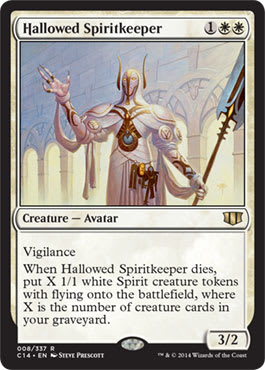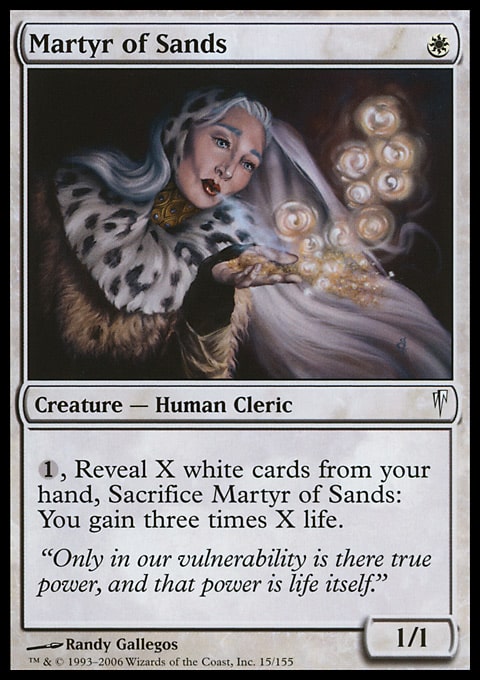In this experiment, we use all the black effects for all the white reasons.
Last week, I rebuilt my first decklist as a Commander deck. It was a mono-white deck that did something well within the range of white’s purview: life-gain. This week, we have another (almost) mono-white deck, but this time, it’s doing something that white’s not quite used to: self-milling.
The first card I had for this week’s deck was Hallowed Spiritkeeper. It’s something from Commander (2014 Edition) that I knew I was going to want to build around somehow. It’s also something that could go straight into my all-permanents Karador, Ghost Chieftain Commander deck. But today, it will be the centerpiece of an (almost) mono-white self-mill deck.
Tossing the Spiritkeeper in with a bunch of existing self-mill archetypes, alongside cards such as Splinterfright and Stinkweed Imp, would be easy. Of course, that’s the reason I didn’t go with that option. Building mono-white seemed to be a much more potent challenge.
Mono-White Self-Mill
Mono-colored decks have the distinct advantage of being able to use artifacts, which can simulate all kinds of effects found in other colors. Today, that behooves us with the existence of Altar of Dementia.
The card also has the benefit of allowing us to move our creatures to the graveyard when we choose to. The more creatures we sacrifice, the more cards we mill, which means we have more and more creature cards in the graveyard for Hallowed Spiritkeeper’s death trigger to make a bunch of Spirits, which can, if we want them to, transform into even more cards in our graveyard.
Millikin is another artifact that helps us out. It ramps our mana while also milling, and if we don’t need the mana, we can just mill. Codex Shredder and Ghoulcaller's Bell are both options as well, but they don’t make mana, and they’re not creature cards in the graveyard for the purposes of the Spiritkeeper.
Finally, cycling creatures let us dig through the deck and put creature cards into the ’yard at the same time. Normal cycling, historically, allows players to reduce the number of lands they play, as the mechanic allows a player to turn in a card for another card, which could be a land. When you cycle a nonland card, you turn a card that’s definitely not a land into one that has the potential to be.
The most common cycling variant (before slivercycling and wizardcycling) is landcycling, which comes in five variations of its own. Of course, we’ll be using plainscycling as offered by Eternal Dragon. Going along with the example from the previous paragraph, this lets us turn in a card that’s definitely not a land for one that definitely is.
Enduring Renewal
The hardest part for me in building this deck was figuring out what to do with Hallowed Spiritkeeper. Sure, making six to twelve Spirits is nice, but it doesn’t end the game the way we might want our deck’s potential combo to.
Cathars' Crusade is one option. With this on the battlefield, a horde of Spirits entering will result in them all becoming huge. If we were to make, say, eight Spirits, they’d all be 9/9s, and we could sacrifice them all to Altar of Dementia to mill someone for seventy-two cards. Alternatively, we could just have a bunch of huge creatures, and with some number of cheap creatures and perhaps a Return to the Ranks, we could generate a massive army that way.
That route is a perfectly reasonable one, but I forewent it for my final decklist. I don’t have a particular reason for that—Cathars' Crusade just never really spoke to me. Instead, I went with a card that was essentially designed for combo but that I rarely see used.
Enduring Renewal will let us reuse Hallowed Spiritkeeper as many times as we can pay
The enchantment also allows us to reuse other dying creatures. One of my favorite combinations, though not particularly potent, was one I actually used years ago in Standard: Enduring Renewal with Dawnfluke. I didn’t include Dawnfluke here, but several 1-drops I included will be useful to sacrifice over and over again.
Salvage Scout will return a Millikin or Altar of Dementia we’ve milled or had destroyed. Tragic Poet does the same thing for Enduring Renewal—perhaps just to keep our hand stocked with a second copy. Of course, if we don’t control an Enduring Renewal, it’s worthwhile to trade in the Poet, even if it’s a permanent exchange. Finally, Martyr of Sands can generate a lot of life with a single activation, and when all our dying creatures are returning to our hand, our number of white cards in hand will be a value we’re able to manipulate by waiting to replay guys until our Martyr has been activated the number of times we desire.
Reanimation
False Defeat, Resurrection, and Angel of Glory's Rise are three of white’s options when it comes to bringing creatures back from the dead. It’s not an effect that’s totally out of white’s wheelhouse, which is why I didn’t mention it in the intro when claiming that this deck would be mono-white with a new spin.
But it’s still not something white does super-often, and it’s not something white can do in the way black can do it. Notably, white doesn’t have anything that can do what a Living Death, a Twilight's Call, or a Rise of the Dark Realms can do.
Emeria, the Sky Ruin, however, is a very strong card that does exactly what we’re discussing in one of the most efficient ways possible: by costing 0 mana and, in fact, generating mana by being a land.
Eternal Dragon resurrects itself, though that’s more of a coincidence when it comes to its non-cycling synergies with the deck.
As a final reanimation effect, however, and as the hinted-at divergence from the mono-white theme, I’ve included Unburial Rites. It’s a black card, but if we mill it, its flashback ability will let us cast it without necessity for any other color of mana. Godless Shrine, though, will give us access to black mana while still being a Plains for Eternal Dragon’s plainscycling.
Charm Peddler—which is a card I forgot to mention in last week’s article as being among the ranks of my first decklist—is a cheap outlet to let us discard an Unburial Rites we can’t cast or creatures we don’t have better use for.
Enduring Spiritkeeper ? Casual | Andrew Wilson
- Creatures (30)
- 1 Charm Peddler
- 2 Martyr of Sands
- 2 Tragic Poet
- 3 Disciple of Grace
- 3 Disciple of Law
- 3 Salvage Scout
- 4 Eternal Dragon
- 4 Hallowed Spiritkeeper
- 4 Yoked Plowbeast
- 4 Millikin
- Spells (10)
- 4 Unburial Rites
- 3 Enduring Renewal
- 3 Altar of Dementia
- Lands (20)
- 11 Plains
- 1 Mistveil Plains
- 4 Emeria, the Sky Ruin
- 4 Godless Shrine
If you want to try a new spin on (almost) mono-white, give this deck a try.
Andrew Wilson
fissionessence at hotmail dot com





























